Click on images to enlarge
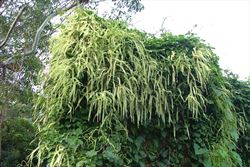
infestation smothering a tree (Photo: Sheldon Navie)

habit climbing a tree (Photo: Sheldon Navie)

habit growing on a fence (Photo: Sheldon Navie)

habit (Photo: Sheldon Navie)
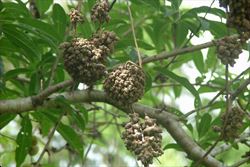
older stems with very large clusters of aerial tubers (Photo: Sheldon Navie)
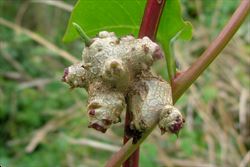
close-up of an aerial tuber and reddish younger stems (Photo: Sheldon Navie)

close-up of the heart-shaped leaves (Photo: Trevor James)
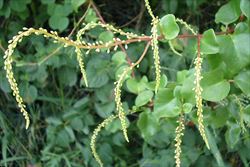
young drooping flower clusters (Photo: Sheldon Navie)

flower clusters (Photo: Sheldon Navie)
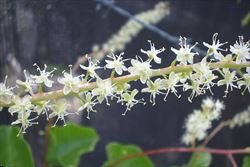
close-up of flowers (Photo: Sheldon Navie)
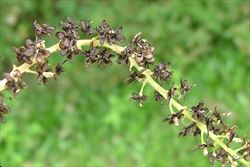
old flowers (Photo: Sheldon Navie)
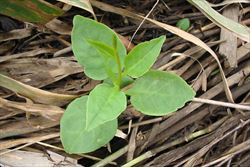
a seedling, or more accurately a "tuberling" (Photo: Sheldon Navie)

a "tuberling" removed from the ground (Photo: Sheldon Navie)
Scientific Name
Anredera cordifolia (Ten.) Steenis
Synonyms
Andredera cordifolia Steenis, orth. var.Boussingaultia cordifolia Ten.Boussingaultia gracilis MiersBoussingaultia gracilis Miers forma gracilis Boussingaultia gracilis Miers forma pseudobaselloides HaumanBoussingaultia baselloides Kunth (misapplied)
Family
Basellaceae
Common Names
bridal wreath, heartleaf madeiravine, jalap, jolop potato vine, lamb’s tail, lamb's tail vine, lamb's tails, Madeira vine, mignonette vine, potato vine
Origin
Native to South America (i.e. Brazil, Bolivia, Colombia, Ecuador, Peru, Argentina, Paraguay and Uruguay).
Cultivation
Madeira vine (Anredera cordifolia) has been widely cultivated as a garden ornamental. While it may often still be seen growing in gardens, it is rarely deliberately cultivated these days.
Naturalised Distribution
Widely naturalised in the eastern and southern parts of the country, but most common and widespread in the sub-tropical and warmer temperate regions of eastern Australia (i.e. in south-eastern Queensland and eastern New South Wales). Occasionally naturalised in central and northern Queensland, south-eastern South Australia, south-western Western Australia and Victoria and sparingly naturalised in Tasmania. Also naturalised on Lord Howe Island and Norfolk Island.
Widely naturalised in other parts of the world including southern Europe (i.e. Spain and Portugal), southern Africa (i.e. Malawi, Swaziland and South Africa), temperate Asia, New Zealand, Mexico, Central America (i.e. Coasta Rica, Honduras and Guatemala), southern USA (i.e. California, Texas, Louisiana and Florida) and some Pacific Islands (i.e. the Cook Islands, Fiji, French Polynesia, Niue and Hawaii).
Habitat
A weed of rainforest gaps and margins, moist woodlands, bushland, waterways and riparian areas, waste areas, disturbed sites, gardens, parks, plantation crops (e.g. sugar cane) and roadsides in wetter temperate, sub-tropical and tropical regions.
Habit
A long-lived (i.e. perennial), twining or climbing plant growing over plants and trees up to 30 m tall.
Distinguishing Features
- a vigorous climbing plant that grows over other vegetation up to 30 m tall.
- its green or reddish younger stems later become rope-like in appearance and produce numerous aerial tubers.
- these greyish-brown or greenish warty stem tubers (normally about 2-3 cm long) are the main means of reproduction and dispersal of this species.
- the heart-shaped leaves (2-15 cm long and 1.5-10 cm wide) are alternately arranged and slightly fleshy in nature.
- numerous small, white or cream, fragrant flowers (about 5 mm across) are borne in elongated, drooping, flower spikes (6-30 cm long).
Stems and Leaves
The stems are hairless (i.e. glabrous) and grow in a twining fashion. Younger stems are green or reddish in colour and round in cross-section. They become rope-like in appearance and turn greyish-brown in colour as they mature. Distinctive greyish-brown or greenish-coloured warty tubers (1-10 cm long, but usually 2-3 cm long) often form at the joints (i.e. nodes) along the older stems.
The leaves are alternately arranged, slightly fleshy (i.e. semi-succulent) in nature, hairless (i.e. glabrous) and sometimes have a glossy appearance. They are borne on leaf stalks (i.e. petioles) 5-20 mm long and are more or less heart-shaped (i.e. cordate) or broadly egg-shaped in outline (i.e. ovate). These leaves (2-15 cm long and 1.5-10 cm wide) either taper to a blunt point or have a somewhat rounded tip (i.e. acute or obtuse apex).
Flowers and Fruit
Plants produce masses of drooping flower clusters (6-30 cm long) which arise from the forks (i.e. axils) of the upper leaves. Each flower cluster (i.e. raceme) bears numerous small, white or cream-coloured, fragrant flowers (about 5 mm across). These star- shaped flowers have five 'petals' (i.e. tepals or perianth segments) and are borne on short stalks (i.e. pedicels) 2-3 mm long. They also have five stamens and an ovary topped with a three-branched style and three tiny club-shaped stigmas. The petals (2-3 mm long) are fleshy, persistent, turn dark brown or black in colour with age, and surround the small fruit. Flowering occurs mostly during late summer and autumn.
Viable seeds are generally not produced in Australia.
Reproduction and Dispersal
This plant occasionally reproduces by seed, but mainly spreads via large numbers of specialised aerial tubers that are produced along the stems. It also spreads vegetatively by tuberous roots and creeping underground stems (i.e. rhizomes).
The tubers are often dispersed in dumped garden waste and contaminated soil. They are also spread shorter distances after falling off stems high in the canopy (i.e. by gravity) and can be transported downstream in floods.
Environmental Impact
Madeira vine (Anredera cordifolia) is a very significant environmental weed in New South Wales and Queensland and is actively managed by community groups in these states. It is also regarded as an environmental weed in Victoria, South Australia and Western Australia, and is listed as a priority environmental weed in eight Natural Resource Management regions throughout Australia.
Madeira vine (Anredera cordifolia) is a highly invasive weed capable of smothering and destroying native vegetation. It is most problematic in moist forests (e.g. damp sclerophyll forests), rainforest margins and riparian vegetation, where it has the ability to establish under an intact canopy and can quickly engulf native species. The growth rate of stems in warmer and moister regions can exceed 1 m per week, and up to 6 m in a growing season. Its climbing stems can totally envelop the canopy layer, while is trailing stems also smother the ground layer of invaded habitats. This reduces light penetration, eventually killing the plants underneath and preventing the germination and regeneration of native plants. The sheer weight of dense infestations can even bring down trees in the canopy layer, and in this way Madeira vine (Anredera cordifolia) can change the structure of invaded communities, eventually destroying them.
This species is currently regarded as one of the five most invasive plants in south-eastern Queensland and among the ten worst weeds in the Gold Coast City Council region. Madeira vine (Anredera cordifolia) also appears on numerous local and regional environmental weed lists in eastern New South Wales and south-eastern Queensland, and has been recorded in a large number of conservation areas in these states (e.g. Mount Etna Caves National Park and Noosa National Park in Queensland and Coocumbac Island Nature Reserve, Stotts Island Nature Reserve, Booti Booti State Conservation Area, Mount Warning National Park, Limpinwood Nature Reserve and Lane Cove National Park in New South Wales).
Not only does it invade conservation areas, including some of the most significant ones in this part of Australia, but it is often seen as one of the major threats to their condition or the integrity of the remnant plant communities that they contain. For example, Madeira vine (Anredera cordifolia) is considered to be the most serious and destructive pest plant affecting rainforest remnants in the North Coast region of New South Wales. It is also regarded as potentially the greatest ecological threat to the world heritage listed Dorrigo National Park, west of Coffs Harbour. Madeira vine (Anredera cordifolia) is also one of the "exotic vines and scramblers" whose invasion of native communities is listed as a "key threatening process" in New South Wales, and it is a major weed of endangered littoral rainforest plant communities in this state.
Madeira vine (Anredera cordifolia) is also a threat to individual rare and threatened plant species. For example, it is considered to be a more immediate threat the endangered Illawarra socketwood (Daphnandra sp. C Illawarra) than the other weed species recorded at sites where this species still occurs in the Illawarra region of southern New South Wales. Madeira vine (Anredera cordifolia) may also be threatening the endangered Coxen's fig-parrot (Cyclopsitta diophthalma coxeni) by degrading the feeding and nesting habitat of this species, particularly in lowland riparian sub-tropical rainforest remnants where figs and other fleshy-fruited rainforest trees are most concentrated.
Madeira vine (Anredera cordifolia) is less abundant and invasive in the southern parts of Australia. However, it is listed as a common invasive garden plant in the Greater Adelaide region in South Australia and grows along creeklines on the Swan Coastal Plain in south-western Western Australia. At present it is relatively rare in Victoria and Tasmania, but it is seen as a potential threat to one or more vegetation formations in Victoria.
Because it quickly proliferates from small vegetative parts (i.e. its aerial tubers), and also survives by underground tubers, Madeira vine (Anredera cordifolia) is notoriously difficult to control. In fact, this species often requires many years of concerted effort to eradicate, and has probably caused more volunteers to give up and walk away from bush regeneration projects in eastern Australia than any other weed species.
Other Impacts
Madeira vine (Anredera cordifolia) is also suspected of poisoning livestock.
Legislation
This species is declared under legislation in the following states and territories:
- New South Wales: Class 4 - a locally controlled weed. The growth and spread of this species must be controlled according to the measures specified in a management plan published by the local control authority and the plant may not be sold, propagated or knowingly distributed (in the Campbelltown, Hornsby, Hunters Hill, Ku-ring-gai, Lane Cove, Lord Howe Island, Manly, Mosman, North Sydney, Parramatta, Pittwater, Ryde, Warringbah and Willoughby local areas only).
- Queensland: Class 3 - this species is primarily an environmental weed and a pest control notice may be issued for land that is, or is adjacent to, an environmentally significant area (throughout the entire state). It is also illegal to sell a declared plant or its seed in this state.
- Western Australia: Unassessed - this species is declared in other states or territories and is prohibited until assessed via a weed risk assessment (throughout the entire state).
Management
For information on the management of this species see the following resources:
- the Biosecurity Queensland Fact Sheet on this species, which is available online at http://www.dpi.qld.gov.au.
- the Campbelltown City Council noxious weeds profile sheet on this species, which is available online at http://www.campbelltown.nsw.gov.au.
- the Sutherland Shire Council weed fact on this species, which is available online at http://www.sutherland.nsw.gov.au.
- the Strathfield Council weed fact sheet, which is available online at http://www.strathfield.nsw.gov.au.
Similar Species
This is a very distinctive plant, especially when in flower, and is rarely confused with other species. The native climbing lignum (Muehlenbeckia adpressa) has similar leaves, but they have finely crinkled (i.e. crisped) margins, and this plant only grows to about 1 m tall.

